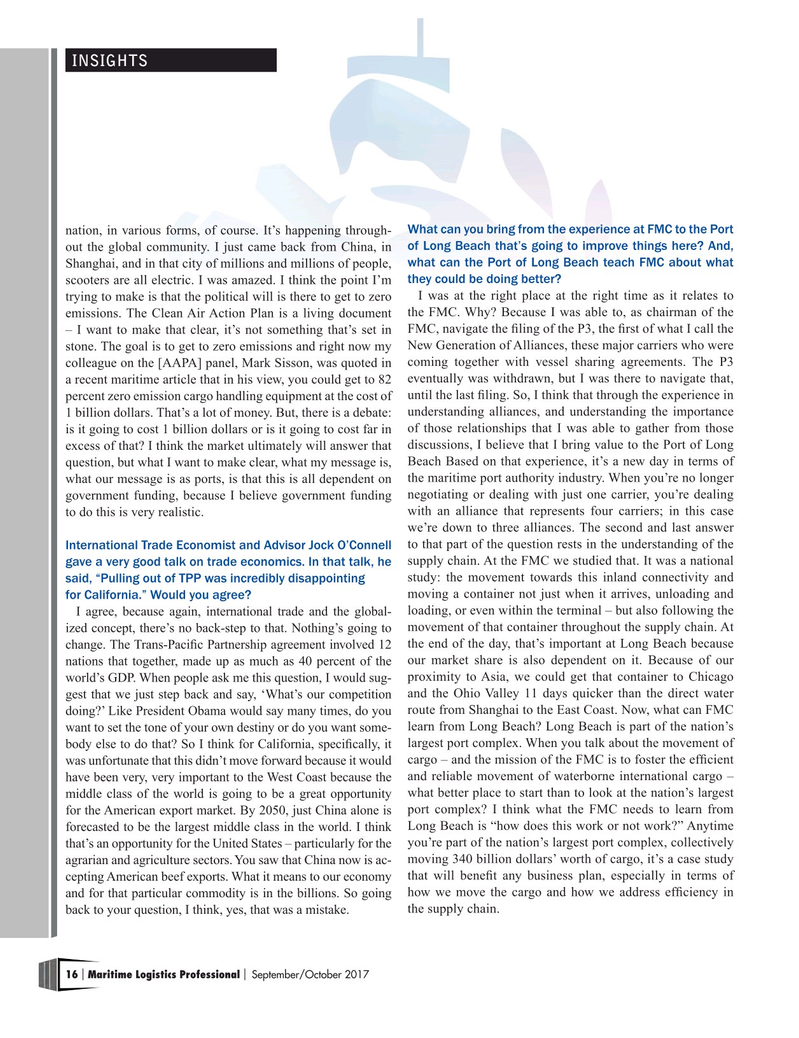
Page 16: of Maritime Logistics Professional Magazine (Sep/Oct 2017)
CONTAINER PORTS
Read this page in Pdf, Flash or Html5 edition of Sep/Oct 2017 Maritime Logistics Professional Magazine
INSIGHTS nation, in various forms, of course. It’s happening through- What can you bring from the experience at FMC to the Port out the global community. I just came back from China, in of Long Beach that’s going to improve things here? And,
Shanghai, and in that city of millions and millions of people, what can the Port of Long Beach teach FMC about what scooters are all electric. I was amazed. I think the point I’m they could be doing better?
trying to make is that the political will is there to get to zero I was at the right place at the right time as it relates to emissions. The Clean Air Action Plan is a living document the FMC. Why? Because I was able to, as chairman of the – I want to make that clear, it’s not something that’s set in FMC, navigate the fling of the P3, the frst of what I call the stone. The goal is to get to zero emissions and right now my New Generation of Alliances, these major carriers who were colleague on the [AAPA] panel, Mark Sisson, was quoted in coming together with vessel sharing agreements. The P3 a recent maritime article that in his view, you could get to 82 eventually was withdrawn, but I was there to navigate that, percent zero emission cargo handling equipment at the cost of until the last fling. So, I think that through the experience in 1 billion dollars. That’s a lot of money. But, there is a debate: understanding alliances, and understanding the importance is it going to cost 1 billion dollars or is it going to cost far in of those relationships that I was able to gather from those excess of that? I think the market ultimately will answer that discussions, I believe that I bring value to the Port of Long question, but what I want to make clear, what my message is, Beach Based on that experience, it’s a new day in terms of what our message is as ports, is that this is all dependent on the maritime port authority industry. When you’re no longer government funding, because I believe government funding negotiating or dealing with just one carrier, you’re dealing to do this is very realistic. with an alliance that represents four carriers; in this case we’re down to three alliances. The second and last answer
International Trade Economist and Advisor Jock O’Connell to that part of the question rests in the understanding of the gave a very good talk on trade economics. In that talk, he supply chain. At the FMC we studied that. It was a national said, “Pulling out of TPP was incredibly disappointing study: the movement towards this inland connectivity and for California.” Would you agree? moving a container not just when it arrives, unloading and
I agree, because again, international trade and the global- loading, or even within the terminal – but also following the ized concept, there’s no back-step to that. Nothing’s going to movement of that container throughout the supply chain. At change. The Trans-Pacifc Partnership agreement involved 12 the end of the day, that’s important at Long Beach because nations that together, made up as much as 40 percent of the our market share is also dependent on it. Because of our world’s GDP. When people ask me this question, I would sug- proximity to Asia, we could get that container to Chicago gest that we just step back and say, ‘What’s our competition and the Ohio Valley 11 days quicker than the direct water doing?’ Like President Obama would say many times, do you route from Shanghai to the East Coast. Now, what can FMC want to set the tone of your own destiny or do you want some- learn from Long Beach? Long Beach is part of the nation’s body else to do that? So I think for California, specifcally, it largest port complex. When you talk about the movement of was unfortunate that this didn’t move forward because it would cargo – and the mission of the FMC is to foster the effcient have been very, very important to the West Coast because the and reliable movement of waterborne international cargo – middle class of the world is going to be a great opportunity what better place to start than to look at the nation’s largest for the American export market. By 2050, just China alone is port complex? I think what the FMC needs to learn from forecasted to be the largest middle class in the world. I think Long Beach is “how does this work or not work?” Anytime that’s an opportunity for the United States – particularly for the you’re part of the nation’s largest port complex, collectively agrarian and agriculture sectors. You saw that China now is ac- moving 340 billion dollars’ worth of cargo, it’s a case study cepting American beef exports. What it means to our economy that will beneft any business plan, especially in terms of and for that particular commodity is in the billions. So going how we move the cargo and how we address effciency in back to your question, I think, yes, that was a mistake. the supply chain.
16 Maritime Logistics Professional September/October 2017 | |

 15
15

 17
17
